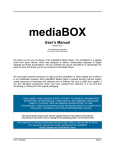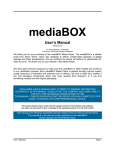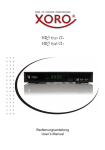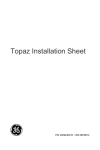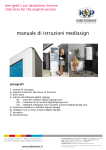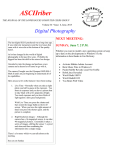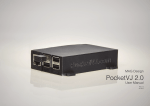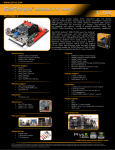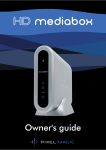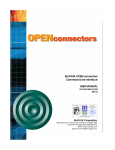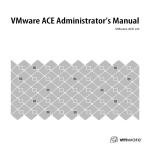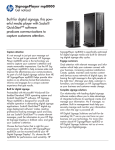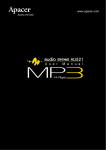Download User`s Manual Template
Transcript
mediaBOX User’s Manual version 2.6 For Windows XP embedded and Ubuntu (G43 base board) We thank you for your purchase of the mediaBOX Media Player. The mediaBOX is a reliable small form factor device, which was designed to deliver uninterrupted playback of Digital Signage and Kiosk presentations. We are confident the device will perform to specification for years to come and thank you for your interest in this Media Player. We have taken extreme measures to make sure the mediaBOX is 100% reliable and conforms to our certification process. Each mediaBOX Media Player is passed through rigorous system quality assurance of hardware and software prior to delivery. Be sure to notify your reseller if you find damaged components which may have resulted from shipment or if you find that something is missing from the original packaging. DISCLAIMER: WHILE MAKING EVERY ATTEMPT TO PRESENT INFORMATION ACCURATELY IN THIS MANUAL / PUBLICATION, THE COMPANY DISCLAIMS LIABILITY FOR ANY LOSS OR DAMAGE ARISING FROM ITS USE. THIS MANUAL / PUBLICATION SHOULD NOT BE RELIED UPON AS A SUBSTITUTE FOR LEGAL, TECHNICAL OR OTHER PROFESSIONAL ADVICE. The manual should only be used with the supplied version of the software and hardware. Any other use may result in loss or damage to the operating system or to the device itself This manual is for Windows embedded standard edition (XPe) or Ubuntu 9.04 32 /64 bit. The manual is to be used as a basic guideline for the mediaBOX Digital Signage and Kiosk Media Player. User’s Manual Page 1 TABLE OF CONTENTS 1.0 GENERAL INFORMATION 1.1 1.2 Package content Pre installation requirements 1.2.1 1.2.2 1.2.3 1.2.4 1.3 1.4 Things to consider Overview 1.4.1 1.4.2 1.4.3 1.4.4 1.5 1.6 1.7 2.0 Network Monitor and video display Capture device USB OS restore system Specifications Formats Panel configuration The Digital Signage Network 2.1 2.2 2.3 2.4 2.5 3.0 Ethernet Wireless Video Sound Connecting to the Digital Signage cloud Registering into the Digital Signage network Broadband Security Firewall Windows Embedded Standard setup and configuration 3.1 3.2 Windows user interface Network setup 3.2.1 Wired network 3.2.2 Wireless network 3.2.3 Host name 3.3 Display configuration 3.3.1 Single Display 3.3.2 Dual Displays 3.3.3 Rotating the Display 3.4 3.5 3.6 3.7 3.8 Running the SignagePlayer Unregistering & clearing cache Maintnance Remote Login White label setup User’s Manual Page 2 4.0 Ubuntu Linux 4.1 4.2 User interface Network setup 4.2.1 Wired network 4.2.2 Wireless network 4.3 Display configuration 4.3.1 Single Display 4.3.2 Dual Displays 4.3.3 Rotating the Display 4.4 4.5 4.6 4.7 4.8 5.0 Running the SignagePlayer Enable HDMI sound Maintenance Remote Login White label setup Monitoring and Administration 5.1 5.2 Watchdog Real time snapshots User’s Manual Page 3 1.0 General Information 1.0 User’s Manual GENERAL INFORMATION 2.0 System Summary 1.1 Package content The mediaBOX Media Player is shipped pre assembled and ready to play. It is a plug N play device which was designed to deliver seamless integration even for none technical individuals. The following is a list of the products you received with the purchase of your new mediaBOX Media Player. Please note that most of these components were pre-installed at the factory. • System Motherboard with built in Video, LAN, NIC and sound interfaces. • Wifi internal USB module with external antenna • Intel based processor ** • Standard CPU fan • Slim hard drive with SATA cables • DIMM2 240 pin Memory ** • Motherboard manual with drivers CD • Internal 150PSU DC-DC convertor • 120V-240V AC-DC convertor • Mini mediaBOX hard metal case with detachable front plate • Motherboard manual and drivers CD • Mounting plates, side brackets, rail mounts, HDD plate, extra fan *** • USB OS Restore system *** − • The OS restore system includes x2 USB Flash drives Internal USB Capture device with external connectors *** − Capture device board with RCA/S-Video pigtail, CD Drivers & plug-in wires ** Component specifications depends on the mediaBOX model ordered *** Item sold separately as an add on accessory User’s Manual 2.0 System Summary 1.2 Pre installation requirements The following are things to consider before you install the mediaBOX Media Player. 1.2.1 Ethernet The mediaBOX is equipped with Ethernet 10/100/1000MB onboard internal network interface card. If you wish to use a wired local area network connection be sure to run Cat 5 twisted per Ethernet cable to the final mounting location of the Media Player. The cable must be plugged in to a LAN switch or router with a maximum distance of 100 meters. Distance may be extended with a repeater. 1.2.2 Wireless The mediaBOX has a built in 802.1x compatible wireless network card. The internal card is connected to one of the six available USB header port that is available on the motherboard. The wireless interface card must be connected to the supplied antenna in order to insure maximum reception of available wifi signal. In order to take advantage of the Wifi capabilities of the mediaBOX Media Player, be sure to install a Wireless router within close proximity. Actual signal strength and maximums wireless distance may vary due to local interference and building layout. You should perform signal quality tests to confirm the device can properly work with your current wireless configuration. 1.2.3 Video The mediaBOX Media Player supports all high definition formats including 720P and 1080i. The Media Player is equipped with VGA / HDMI and DVI video ports. Be sure to prepare the proper cabling to connect the Media Player directly to your LCD or Plasma screen. You may need a convertor (i.e.: HDMI to DVI) to establish proper connections between the Media Player and legacy devices. 1.2.4 Sound The mediaBOX Media Player supports high definition sound. You have the option of using the optical, coax or mini jack sound ports. If you wish to have support for audio be sure to consider the physical installation of the speakers. Refer to the back panel diagram for a complete layout of all audio ports. 1.3 Things to consider The mediaBOX Media Player is an advanced device which needs to be handled with care. It’s important to install the device in areas where room temperature does not exceed 90 degrease Fahrenheit (32.22 Celsius). External heat may cause the device to overheat internally. Be sure to protect the device from theft by hiding it behind a monitor or other enclosed furniture. The mediaBOX is designed to auto restart after a power outage. Uninterrupted power supply is not necessary for safe operation of the Media Player. User’s Manual 2.0 System Summary 1.4 Overview 1.4.1 Network The mediaBOX depends on reliable internet connectivity to get data updates, stream down media files into its caching repository and report back to the server and SignageStudio on its own health status. Once files are cached the Media Player will only communicate back with the hosted Digital Signage servers if an update is initiated from the SignageStudio, or if the Media Player is rebooted. A constant internet connection (a connection that is always up and active) is not required as the mediaBOX Media Player will cache content internally (using the internal hard drive). The mediaBOX also supports manually updating content via portable devices such as a USB flash drive. Manual content update can be used in areas where internet connection is not available. You may choose to connect to the local area network via wireless or wired interface. The wireless method reduces cabling requirements and is normally the preferred way of connection when installing the Media Player behind a monitor. The mediaBOX is shipped with DHCP enabled and will automatically retrieve an IP from a local area network DHCP Server or NAT enabled router. You may reconfigure TCP/IP settings. Refer to the Ubuntu / Windows XPe respectively for further information on configuring network connections. The mediaBOX does not require a static IP; auto assigned private IPs are fully supported. The mediaBOX internal firewall is disabled by default. All egress and ingress communication is done over the TCP/IP protocol and live socket connection exists between it and the backend digital signage server cloud. 1.4.2 Monitor and display setup The mediaBOX supports up to two monitors consecutively. It includes VGA / DVI / HDMI connections through the back panel. You may choose a combination of any two types of connectors to achieve a dual display setup. Two monitors of same or different resolution may be connected to produce a total desktop width or height, which is the total resolution combined. If the monitors are configured in a landscape mode the total desktop width is monitor A width + monitor B width. If the monitors are configured in portrait mode the total desktop height is monitor A height + monitor B height. User’s Manual 2.0 System Summary 1.4.3 Capture device The mediaBOX may be purchased with a built in Capture device (also known as a TV Tuner card). A capture card will allow you to connect external peripherals and display the output of these devices directly onto a specified screen division. The capture card connections include SVideo and RCA Audio / Video inputs. The capture device can be connected to any input source including external DVD players, satellite box, cable box, security camera systems and others. The capture device can be configured using the SignageStudio using one of two methods: Method #1: Use the Capture / Web Component in the SignageStudio to assign a capture device into a screen division. Using this method you may experience some latency, average quality with interlacing. This method is also processor intensive as all captured frames must pass through the Flash / AIR Adobe virtual machine. On the up side, it is easy to setup and requires no special configuration. Method #2: Use the External Application Component in the SignageStudio. The External application can take any external binary executable and so no CPU overhead is involved in the capturing process (frames processed by the Video card’s GPU) and no latency will be present. The recommended applications to be used to achieve this setup are TVTime (Ubuntu), Virtual Dub (Windows) or VLC (Windows and Ubuntu); all are open source, freely distributed and are pre installed and configured on the mediaBOX Media Player. 1.4.4 USB OS restore system The USB operating system restore device may be purchased as an add-on accessory for the mediaBOX Media Player. The USB OS restore system allows for a complete restore of the entire OS (Windows XPe or Ubuntu) in about 60 seconds. This is ideal for environments where customers are interacting with the device (Kiosks / Internet Cafés) and may corrupt the underline OS. In such environments the USB OS restore system allows for a quick and easy way to get the mediaBOX Media Player up and running in no time. Another key advantage of the USB OS restore system is the ability to easily upgrade the entire OS into the latest software revision. Simply download the last released mediaBOX OS build User’s Manual 2.0 System Summary from your reseller’s web site and onto the supplied USB flash device. Once the download is complete you may follow the steps below to apply the new OS image to the Media Player. The USB OS restore system includes (2) USB flash memory devices. The 1st USB device marked as “Program” contains the restore utility which is used to boot into the restore application. The 2nd USB marked as “Image” holds the operating system (Windows XPe or Ubuntu) that is used to restore back the complete OS to its default state. The following section describes in the detail the process required to restore a Windows XPe or Ubuntu Linux OS back to the factory defaults. Operating systems restore point procedures: Attention: please note that imaging your mediaBOX Media Player will erase all its content including cached media files. It will completely wipe out your existing hard disk. You should make backups of any files or data which you would like to save. Note that you do not need to backup any files for proper operation of the mediaBOX. Once you reimage the Media Player you will be prompted to re-register with your login email and password. Once you complete registration and select the campaign to join, the SignagePlayer will download your digital signage or kiosk configuration and begin to re-cache all resource files. Begin by inserting the two supplied USB flash memory cards into any available USB ports. Next, turn on the mediaBOX Media Player. As soon as the first bootup screen appears, press the [Delete] key to enter the BIOS config mode. User’s Manual 2.0 System Summary On the main BIOS screen select “Advanced BIOS features”. On the “Advanced BIOS features” change the 1st Boot Device to USB-ZIP, change the 2nd Boot Device to USB-FDD and change the 3rd Boot Device to ZIP-100. Next use the arrow keys to move around the menus and select the “Hard Disk Boot Priority”. Press [ENTER] to view the properties. Use the Page Up and Page Down keys and set the 1st item to “Bootable Add-in Cards”. User’s Manual 2.0 System Summary Next press F10 to save changes and [ESC] to exit and reboot the device. Once the Media Player is rebooted it should enter the OS restore utility program. NOTE: If you get an error of “Remove Disks or other Media, Press any key to restart”, you will need to swap the two USB locations. Once they are swapped, reboot the mediaBOX one more time. On the main restore utility screen press [ENTER] to continue (this is the orange menu screen). 1. Select default “en_us UTF-8” English User’s Manual 2.0 System Summary 2. Select default “Don’t touch keymap” 3. Select default “Select Mode: Start” 4. Select default “device-image work with disk or partitions using images 5. Select default “local_dev Use local device (e.g.: hard drive, USB drive) 6. Select default “Press Enter to continue…” 7. Select Flash USB Drive (4GB – 8GB Drive) 8. Select default “top_directory_in_local_device” 9. Select default “Press Enter continue 10. Select default “Beginner mode: Accept default options” 11. Select “restoredisk Restore_an_image_to_local_disk User’s Manual 2.0 System Summary 12. Select the image you would like to restore 13. Select default “80GB” hard drive 14. Select default “Press Enter continue 15. Enter “y” and Enter to continue when asked to confirm 16. Enter “y” and Enter to continue when asked to confirm again 17. When restore is done, remove the USB drives and reboot the Media Player To update and re-image the entire operating system with a new version image, you must first download the new image from your reseller’s web site. The OS image is in a zipped file format. Unzip the file onto the 2nd USB device labeled as “Image”. Make sure that the unzipped directory resides on the root of the USB. For example, if the unzipped image you downloaded contains a base folder name “LinuxVersion14”. The “LinuxVersion14” must reside directly on the root of the USB “Image” device and not within any other sub directories. Once the newly downloaded folder is unzipped onto the USB flash device, you may follow the steps above to completely reimage the entire operating system with the new version. 1.5 Specifications GeForce 9300 GPU• GPU clock: 450 MHz (Overclockable) Shader clock: 1200 MHz (Overclockable) 16 stream processors Microsoft DirectX 10 with Shader Model 4.0 compatible Low profile super quite, single fan system External DC-DC Power supply Ultra small form factor design Intel Core 2 Duo™ Intel Core 2 Quad™ Intel Core 2 Extreme™ Intel Pentium™ family Up to 1333 MHz FSB support LGA775 Socket compatible Up to 1333 MHz FSB User’s Manual 1 HD Audio Port (Line-in, Line-out, MIC-in)• 1 SPDIF Coaxial connector• 1 SPDIF Optical connector• 1 PS/2 Keyboard Port• 1 COM port header• 12 USB 2.0 (6 on back panel, 6 via pin header)• 1 RJ45 Port (Gigabit Lan) 1 VGA 1 DVI (w/Audio) 1 HDMI (w/Audio) 1 NVIDIA nView multi-display (up to 2 monitors) Dual Channel DDR2• DDR2 667/800• 2 x 240 pin DDR2 DIMM slots• Up to 8GB ram 1 PCI Express 2.0 x16 (needs different case) 2.0 System Summary OS options: No Operating system Microsoft ™ windows standard edition embedded peripheral Linux Ubuntu 9.04 peripheral optimized 2 SATA 3.0 Gbps ports• 1 e.SATA 3.0 Gbps port• SATA RAID 0, 1• Plug N play installation Designed for the SignagePlayer 30 days direct warranty 1 Year warranty with manufacturer Extended warranty sold separately Windows XPe details: Requires licensing per single OS Ultra light Windows manager used No Desktop icons and no shortcuts Pre loaded with SignagePlayer Pro Disabled Adobe AIR auto build updates Disabled all screen saver Disabled all balloon & other OS messages Disabled scan disk and other file checks Removed Taskbar Set as appliance mode device Pre loaded with all supported drivers Removed services and TSRs not needed 1.6 NVIDIA PureVideo HD support• NVIDIA Hybrid SLI with GeForceBoost• NVIDIA Unified Architecture• NVIDIA CUDA Ready• NVIDIA PhysX Ready• Native HDMI with HDCP• Integrated 802.11b/g WiFi 2 SATA cable• 1 SATA power cable All components are none proprietary and upgradable Ubuntu Linux details: Requires no licensing, freely distributed OS Ultra light Windows manager (source Black Box) No Desktop icons and no shortcuts Pre loaded with SignagePlayer Pro Disabled Adobe AIR auto build updates Disabled all screen saver Disabled all balloon & other OS messages Disabled fstab and other file checks Removed Taskbar Set as appliance type application Pre loaded with all supported drivers Removed daemons and TSRs not needed Formats The Player supports all of the native Flash 10.X+ formats which include the following: Video Formats: Flash video FLV (H.263), MPEG-4 (H.264) ,MOV, M4A, MP4V, 3GP, 3G2, AAC (HE, LC), SWF Animation: SWF Images: JPG, PNG Sound: MP3 You may also use the External Application component of the SignageStudio to integrate binary external applications into an assigned screen division. This allows you to use applications such as the open source freely distributed media player software called Video LAN (aka VLC). To learn more about VLC and its supported formats you may visit the following link: http://www.videolan.org/vlc/features.html User’s Manual 2.0 System Summary 1.7 Panel configuration The image below maps the main ports of the BACKBOX back panel User’s Manual 2.0 System Summary 2.0 User’s Manual THE DIGITAL SIGNAGE NETWORK 3.0 Getting Started 2.1 Connecting to the Digital Signage Cloud The Digital Signage network cloud is comprised of network servers and routers which are hosted at central data centers. The hosted servers provide all services to your Digital Signage network. This type of service is often referred to as SaaS (software as a s service). The services include authentication, streaming of media files and database services. In order for the mediaBOX Media Player to join this cloud, you must first register the Media Player. Next you will need to insure that the Media Player can transmit ingress and egress data from and to the digital signage cloud. The following sections will cover requirements for proper operation and transmission of your mediaBOX within the SaaS model. 2.2 Registering into the Digital Signage networks The mediaBOX ships preloaded with a stable version of the SignagePlayer. When a Media Player boots up, the SignagePlayer is configured to automatically start. On the 1st boot up you will be prompted to enter your login email and password. These will be the same email and password you use to login to the SignageStudio. Once you provide this information, the Media Player will be associated with your account. After proper authentication is completed, the Media Player will be allowed to join your digital signage network. Once successfully registered, the SignagePlayer will prompt you to select the campaign and output that you would like to connect to. The campaign and output can be modified at a later time through the SignageStudio “Stations”. 2.3 Broadband The mediaBOX Media Player relies on a broadband connection to download all of the campaign’s data. This includes RSA authentication, XML configuration and media files. It also uses the broadband to access external data sources such as RSS, video podcasts and other data. It is vital to a successful integration of a digital signage solution that you provide a fast reliable internet connection. It should be noted that the SignagePlayer will work with almost any type of connection; the SignagePlayer uses internal caching and retry mechanisms to insure smooth playback at all times. The SignagePlayer will not be affected when internet connection is down given that all resources had an opportunity to cache locally. The SignagePlayer may also be rebooted when no connection exists; in such scenarios the SignagePlayer will roll back to the last good known campaign. However, a fast broadband connection will allow for rapid download of content, smoother transitions into new content and more reliable remote control functionality. User’s Manual 3.0 Getting Started 2.4 Security The SignagePlayer uses an elaborate authentication scheme to validate against the Digital Signage servers. Once fully authenticated, the SignagePlayer will be allowed to join the Digital Signage cloud. The SignagePlayer uses 128 bit private and public keys. It is powered by RSA ciphering cryptography to insure maximum security. All tokens used are validated on the server side before they are allowed to pass through. The SignagePlayer stores the authenticated password locally within the local file system as an encrypted key. If you plan on moving the Media Player or possibly shipping it to an offsite location, consider first unregistering the SignagePlayer. Unregistering the SignagePlayer will remove it from the Digital Signage cloud as well as remove all locally saved passwords. 2.5 Firewall The SignagePlayer communicates with the hosted servers over TCP/IP. The protocol uses http (as well as RSA public / private keys over standard http) and raw sockets. In order to insure proper operation the SignagePlayer must be allowed to communicate with the hosted servers within the Digital Signage network. The mediaBOX does not include an internal firewall and so no special configuration is required. However if your local area or corporate network does have a firewall, you will need to insure proper rules exist within your firewall to allow traffic originating from the mediaBOX to pass through. If you are having issues connecting to our server you must have issues with a local firewall. We support both LIVE Sockets as well as HTTP Polling. Under the SignageStudio > Stations you may get 3 color indicators: Yellow: connected via Polling Green: connected via live socket Red: not connected at all To learn more about this and how it is setup, please watch this video tutorial: Note that if you have a firewall with an existing port 80 rule, this may NOT be enough. The reason is that many firewalls will only allow HTTP traffic. However, the mediaBOX communicates using a persistent TCP/IP socket connection. You may need to add a rule in your gateway / router to specifically allow connection oriented traffic over port 80 (not just HTTP). You should know that opening port 80 on your firewall does not compromise in any way the security of your local area network. Allowing trusted traffic originating from within the LAN onto a specific destination is common practice. It does not induce any potential security breach. This is acceptable and standard procedure in internet security models. User’s Manual 3.0 Getting Started 3.0 User’s Manual Windows Embedded Standard setup and configuration 4.0 Using the System (Online) 3.1 Windows user interface The mediaBOX Media Player was designed as a plug-N-play device. The Media Player requires very little maintenance after the initial setup. The Windows XPe was compiled with a light weight windows manager. In order to fully optimize memory and resources the windows was stripped down from both Desktop and Taskbar controls. The main user interface is the Task Manager. The Task Manager allows you to accomplish basic tasks including execution of installed applications, restart, shutdown and basic process management. To access the Task Manger press Control > Alt > Delete sequentially. This will open the Task Manager and expose the File > Run command interface. The run command interface is used to execute applications. 3.2 Network setup 3.2.1 Wired Network The mediaBOX ships with DHCP enabled by default. To access the wired network configuration: 1. press Control > Alt > Delete to open the Task Manager 2. On the Task Manager select File > run 3. Type control and select ok. This will open the main control panel. User’s Manual 4.0 Using the System (Online) 4. Select network connections 5. Double click the main network interface 6. Configure static IP information or DHCP settings 3.2.2 Wireless Network The mediaBOX ships with DHCP enabled by default. To access the wireless network configuration: 1. 2. 3. 4. 5. 6. Press Control > Alt > Delete to open the Task Manager On the Task Manager select File > run Type control and select ok. This will open the main control panel. Select network connections Double click the wireless network connections Click refresh network list and search for your local area wireless network. Double click to connect to a selected network User’s Manual 4.0 Using the System (Online) 3.2.3 Host name The mediaBOX comes preconfigured with a default host name called OEM. When running multiple mediaBOXes in the same virtual network, you may encounter an error on the screen since multiple mediaBOXes have the same host name. The Windows OS requires that each host has a unique identifier. To apply a unique name to each one of your mediaBOXes follow these steps: 1. Press Control > Alt > Delete 2. Select File > run and type regedit, and then click OK. 3. Locate the following registry key: HKEY_LOCAL_MACHINE\SOFTWARE\Microsoft\Windows NT\CurrentVersion 4. To change the company name, do the following: In the right pane, double-click RegisteredOrganization. Under Value data, type the name that you want, and then click OK. To change the name of the registered owner, do the following: In the right pane, double-click RegisteredOwner. Under Value data, type the name that you want, and then click OK. Click Exit on the File menu to quit Registry Editor. User’s Manual 4.0 Using the System (Online) 3.3 Display configuration The mediaBOX Media Player comes with 3 types of display connections including VGA, DVI and HDMI. You may use any one of these ports for your main display. The mediaBOX Media Player also supports up to two active monitors per single box. When using two monitors you will have a desktop space which is a total of both monitor resolutions combined. In other words, you may create a signage presentation that spans both monitors. You can also configure the monitors in landscape or portrait mode. 3.3.1 Single Display To configure the resolution of your display: 5. Press Control > Alt > Delete 6. Select File > run and type control 7. Under the control panel double click on Display 8. Select the settings tab 9. Select the resolution you wish to set using the resolution slider 10. You may also configure color quality and other standard display properties 3.3.2 Dual Display The mediaBOX Media Player allows you to use any 2 of the 3 available video ports (i.e.: VGA and DVI, DVI and HDMI, HDMI and VGA, etc). Once you connect both displays, you should see both monitors appear under the Display settings. User’s Manual 4.0 Using the System (Online) To enable the secondary display, select the 2nd inactive monitor and click on the checkbox “Extend my Windows desktop onto this monitor”. Note that you may also drag and drop each display box within the gray canvas to change the order and match your physical mounting installation. You should know that in your Signage presentation a single screen division cannot surpass 2880 pixels in width or height. If the total width or height of both monitors exceeds 2880 pixels, you will need to break your screen setup into at least two divisions to compensate for this limitation. In most cases this is not a problem as multiple screen divisions The SignagePlayer are used. supports unlimited number of screen divisions. 3.3.3 Rotating the Display The mediaBOX Media Player allows you to set each display in a landscape or portrait mode. To configure the rotation of the display you will use the Nvidia nView setup software. To configure rotation of your display: 1. Press Control > Alt > Delete 2. Select File > run and type control 3. Under the control panel double click on Display 4. Select the settings tab 5. Select the monitor you wish to configure using the Display drop down 6. Click on advanced 7. Select the Nvidia configuration tab 8. Select Start Nvidia Control Panel 9. Select the Display icon 10. Select Rotate Display User’s Manual 4.0 Using the System (Online) 11. Select the angle in degrees to rotate the display to 12. Select apply 3.4 Running the SignagePlayer Running the SignagePlayer should always be done via SignageController.exe. It is the SignageController that executes the SignagePlayer. The SignageController is set automatically start upon bootup. The following registry key was modified in order to set the SignageController.exe to auto start: HKEY_LOCAL_MACHINE\SOFTWARE\Microsoft\Windows\CurrentVersion\RUN To review this you can execute: 1. Press Control > Alt > Delete 2. Select File > Run 3. Enter regedit.exe Note: The Registry is the main config database of the Windows XPe OS. Editing the registry is a high risk task. Modification of keys may cause the Windows registry to corrupt. Take special care when adding, modifying or deleting any entries in the registry. 3.5 Unregistering & clearing cache User’s Manual 4.0 Using the System (Online) You can unregister your account directly on the SignagePlayer. Simply click on the “Unregister” button, provide your login email address and valid password and click ok. This will remove the local key and unregister your account with the SignagePlayer. It will also unregister the Player with the remote server and remove the Player from the list of available “Stations”. You may also delete the SignagePlayer local cache directory for one of the following reasons: 1. You forgot your login email or password 2. You want to remove all cached content from Player including media files and RSS data 3. SignagePlayer is not working properly & you want to troubleshoot the issue by clearing everything The SignagePlayer stores all account information and local cached content under: C:\Documents and Settings\Administrator\Application Data\SignagePlayer* To delete this directory follow the steps: 1. 2. 3. 4. 5. 6. 7. 8. 3.6 Close the SignagePlayer Close the SignageController Press Control > Alt > Delete Select File > run and type Explorer Change directory to C:\Documents and Settings\Administrator\Application Data Delete the SignagePlayer* directory (* to be replaced with a very long number) Reboot the Media Player Re-register the SignagePlayer upon bootup Maintenance The mediaBOX Windows XPe edition does not require any special maintenance. The scandisk and other normal disk utilities were removed as the OS is designed to work as a peripheral. It is however common practice to reboot or PC at least once a day. Although the SignagePlayer will run continuously without interruption for weeks or even months at a time, it is common practice to reboot once every 24 hours. Rebooting may help increase performance as system buffers will be refreshed and memory restored to zero fragmentation. User’s Manual 4.0 Using the System (Online) To configure a daily reboot, first register the SignagePlayer. Once registered open the SignageStudio, under “Stations” you will see your newly added BLACKBLOX player appear under the “Stations” data grid. Select it, and under its Properties > Reboot conditions set the checkbox. Set a time when you wish to set the automatic daily reboot. By default the SignagePlayer will reboot at 0:0 which is 12:00AM. Note that there are other configurable reboot conditions as well which may cause the SignagePlayer to reboot, this includes memory threshold and internal error. These settings are applicable to both the Windows XPe OS as well as Ubuntu Linux OS. The Automatic Adobe AIR auto updates were disabled in order to prevent popup messages which may come up during new Adobe AIR software releases. To enable the automatic updates temporarily so you can find out if a new Adobe AIR runtime is available you can run: "C:\Program Files\Adobe AIR Settings Manager\Adobe AIR Settings Manager.exe" and click “Enable Updates”. User’s Manual 4.0 Using the System (Online) 3.7 Remote Login The Desktop SignagePlayer can be remotely controlled using the SignageStudio (Web or Desktop version). The remote functions include Play, Stop, update software builds, receive a live screen capture, poll memory stats and more. Under normal circumstances you should not need any further remote functionality. However, it is a good idea to plan for disaster recovery. Part of this plan is to allow for secure remote desktop access to the mediaBOX over the internet. This type of access can be managed with the free service: LogMeIn® (visit http://www.LogMeIn.com). The LogMeIn® service will allow you to bypass firewalls and other restrictions to gain remote access to the mediaBOX. With LogMeIn® installed and preconfigured on your mediaBOX you will always have remote access to your Digital Signage player; just in case. Read the end user license agreement at LogMeIn® for further details on the service and commercial / none commercial offering. A second option of gaining remote secure access to your mediaBOX is to use the free application Tight VNC (visit http://www.tightvnc.com/ ). Note that with TightVNC you will need to use a static IP or use a port forwarding rule on your local internet gateway / router. Again, both LogMeIn® and TightVNC are optional as the SignageStudio provides all of the essential remote management functions needed to operate and control the Desktop SignagePlayer. 3.8 White label setup The Windows XPe is configured to display a custom boot up image. The image may be replaced with your own custom image. To modify the boot up image you must first create a windows bitmap (bmp) image file. The image must be 640x480 and set to 16 colors. Save the image under C:\Windows\boot.bmp. The c:\boot.ini file specifies a boot logo flag which instructs the operating system to pre load the custom image during bootup. The following is a sample c:\boot.ini file [boot loader] timeout=0 default=multi(0)disk(0)rdisk(0)partition(1)\WINDOWS [operating systems] multi(0)disk(0)rdisk(0)partition(1)\WINDOWS="Microsoft Windows Embedded Standard" /fastdetect /noguiboot /bootlogo /noexecute=AlwaysOff User’s Manual 4.0 Using the System (Online) 4.0 User’s Manual Ubuntu Linux setup and configuration 5.0 Using the System (Batch) 4.1 User Interface The Ubuntu Linux operating system was specifically compiled to serve as an appliance type device. The OS was loaded with an ultra light X11 Window Manager. The Window Manager shell was stripped from al panels and desktop area to deliver the most efficient and reliable platform. However you can still get the full power of the gnome Window Manager that is available for you to setup and management. To learn more about gnome you may visit: http://www.gnome.org To access the gnome panel right click on the black background and select Task Manager. Right clicking on the black background will pull additional menu options including reboot, open terminal and more. You should explore the gnome panel to familiarize yourself with the available applications and utilities. Some of these applications include computer management, task manager and others. In the following sections we will cover the core configuration utilities that help with setting up the network and display properties. 4.2 Network setup 4.2.1 Wired Network The mediaBOX ships with DHCP enabled by default. You can check network status by opening the gnome panel, right click the black background and select Task Manager from the mouse right click properties menu. This will run the gnome management top panel. Once the Task Manager loads you will see arrows or wireless icon at the right corner of the top gnome panel: If the icon displays arrows it means you are connected to a wired network. A wireless signal strength icon indicates a connection to a wireless network. To configure your TCP/IP wired network connection: 1. Right click on the black background and select Task Manager 2. From the gnome Task Manager select System > Preferences > Network Connections 3. Select the wired tab User’s Manual 5.0 Using the System (Batch) 4. 5. 6. 7. 8. Select network interface (Auth eth0) Select Edit Select the IP4 settings Select the type of connection you want and set the IP setting Click apply to save changes 4.2.2 Wireless Network The mediaBOX is preconfigured with a wireless module. The following section covers the wireless configuration necessary to enable wireless connectivity to your local secure wireless network. Note that you should have a strong wireless router in close proximity to the mediaBOX to achieve good enough signal strength for smooth operation of your SignagePlayer. If your wireless icon appears on the right corner it means you are currently not using the wired Ethernet connection. Also, if an exclamation appears next to it, it means you wireless network configuration is still not configured. User’s Manual 5.0 Using the System (Batch) 1. Right click on the black background and select Task Manager 2. From the gnome Task Manager select System > Preferences > Network Connections 3. Select the wireless tab 4. OR instead of following steps 1-3, you can click on the wireless icon directly from the taskbar as shown below 5. Once selected, you will be prompted to enter a wireless network key User’s Manual 5.0 Using the System (Batch) 6. Next you will need to provide the root password The root password is: password 7. Once all fields are authenticated the wireless status bar and signal strength will appear on the gnome panel 8. Next you will need to save and store the wireless password locally. This will eliminate the need to provide a password every time the mediaBOX boots up. On the gnome panel click on System > Preferences > Network Connections. This will open the Network connections Dialogue. Select the 2nd tab: Wireless. 9. Click on your wireless network (Auto SignMon in our example ) and click on Edit 10. Now select the Wireless Security tab User’s Manual 5.0 Using the System (Batch) 11. Next enter the password key again under Key:\ 12. And be sure to select the Available to all users checkbox (important) 4.3 Display Configuration The mediaBOX Media Player comes with 3 types of display connections including VGA, DVI and HDMI. You may use any one of these ports for your main display. The mediaBOX Media Player also supports up to two active monitors per single box. When using two monitors you will have a desktop space which is the total of both monitor resolutions combined. In other words, you may create a signage presentation that spans both monitors. You can also configure the monitors in landscape or portrait mode. User’s Manual 5.0 Using the System (Batch) 4.3.1 Single display To configure the mediaBOX screen display 1. Right click on the black background and select Task Manager 2. System > Preferences > Monitor 3. This will open the monitor preferences. If you have two monitors configured; the mediaBOX will detect each one and you can configure the resolution accordingly. The display configuration screen allows you to control resolution, video Hz and detect monitors. 4.3.2 Dual display You may also drag and drop each display box within the gray canvas to change the order and match your physical mounting installation. In your Signage presentation a single screen division cannot surpass 2880 pixels in width or height. If the total width or height of both monitors combined exceeds 2880 pixels, you will need to break your screen setup into at least two divisions to compensate for this limitation. In most cases this is not a problem as multiple screen divisions are used. The SignagePlayer supports unlimited number of screen divisions. User’s Manual 5.0 Using the System (Batch) 4.3.3 Rotating the display The device driver allows you to rotate your display in portrait or landscape mode. To set this up, selects the Rotation from the main configuration menu and set left, right or normal respectively. User’s Manual 5.0 Using the System (Batch) 4.4 Running the SignagePlayer The mediaBOX Media Player is configured to preload the SignagePlayer and SignageController upon bootup. It is configured to run the gnome Windows Manager. The following is the main startup configuration file: /home/user/.config/autostart/SignagePlayer.desktop which in turn runs: /opt/SignagePlayer/share/linux/startSignage.sh #!/bin/sh bbkeys & sudo chmod 777 -R /opt/SignagePlayer/share/linux sudo xterm -geometry 60x40+10+10 /opt/SignagePlayer/share/linux/signageController.sh & sleep 3 /usr/bin/blackbox The Black Box startup config file (.bbstartup) will launch the signageController.sh which is the proper (and only) way of executing the Digital Signage and Kiosk presentation. The signageController.sh script is responsible for launching the SignageController and the SignagePlayer. It also maintains the health status of the SignageController and validates the integrity of all running processes. The SignagePlayer installation resides in /opt/SignagePlayer The SignagePlayer Linux configuration resides in /opt/SignagePlayer/share/linux Cached content resides in /opt/SignagePlayer/share/buisnessXXX where XXX is your business account number. The Linux environment comes with several command line aliases. These aliases are quick shortcuts which can be execute from any open terminal. sign_run sign_cd sign_unregister sign_clear sign_showActive sign_time 4.5 = runs the Signage shell startup script = change to SignagePlayer Linux directory = unregister the account and clear all cached cookie info = remove all cached content = print all active signage relayed processes = configure timezone HDMI Sound The Ubuntu mediaBOX is pre configured with standard audio through the back green mini jack output port. In order to enable HDMI sound through the HDMI port you should follow these steps: 1. Right click on the black background and select Task Manager 2. System > Preferences > Sound 3. Switch to the Hardware tab User’s Manual 5.0 Using the System (Batch) 4. From the profile drop down select Digital Stereo HDMI output You can go back and forth between HDMI and Analog stereo input depending on your configuration requirements. You can also control the audio outout levels and other parameters through the sound configuration utility. 4.6 Maintenance The mediaBOX Linux edition does not require any special maintenance. The fstab auto validation and other normal disk utilities were removed as the OS is designed to work as a dedicated peripheral. It is however a common practice to reboot the mediaBOX at least once per day. Although the SignagePlayer will run continuously without interruption for weeks or even months at a time, it is recommended to reboot once every 24 hours. Rebooting may help increase performance as system buffers flush and memory restored to zero fragmentation. User’s Manual 5.0 Using the System (Batch) To configure a daily reboot, first register the SignagePlayer. Once registered open the SignageStudio, under “Stations” you will see your newly added mediaBOX player appear under the “Stations” data grid. Select it and under its Properties > Reboot every day set the radio button. Set a time when you wish to set the automatic daily reboot. By default the SignagePlayer will reboot at 0:0 which is 12:00AM. You can also choose between rebooting the whole mediaBOX (station) vs restarting only the SignagePlayer (Player) Note that there are other configurable reboot conditions as well which may cause the SignagePlayer to reboot, this includes memory threshold and internal error. These settings are applicable to both the Windows XPe OS as well as Ubuntu Linux OS. The Automatic Adobe AIR auto updates were disabled in order to prevent popup messages which may come up during new Adobe AIR software releases. To enable the automatic updates temporarily so you can find out if a new Adobe AIR runtime is available you can run: /opt/ Adobe AIR Settings Manager/bin/Adobe AIR Settings Manager and click “Enable Updates”. The Ubuntu automatic software updates were also disabled in order to prevent unnecessary downtime of the Media Player. If you would like to enable the automatic updates to check if new software is available: 1. 2. 3. 4. Right click on the black background and select Task Manager On the gnome panel select System > Administration > Update Manager Click on Check to find new software updates Once the check is done, click on Install Updates to proceed with the install User’s Manual 5.0 Using the System (Batch) 4.7 Remote Login The Desktop SignagePlayer can be remotely controlled using the SignageStudio (Web or Desktop version). The remote functions include Play, Stop, update software builds, receive a live screen capture, poll memory stats and more. Under normal circumstances you should not need any further remote functionality. However, it is a good idea to plan for disaster recovery. Part of this plan is to allow for secure remote desktop access to the mediaBOX over the internet. The Ubuntu mediaBOX ships preconfigured with remote access. To enable remote access: 1. Right click on the black background and select Task Manager 2. On the gnome panel select System > Preferences > Remote Desktop 3. Select the “Allow other users to view my desktop” 4. Select the “Allow other users to Control my Desktop”. 5. Close preferences At this point you should be able to install TightVNC viewer on your personal Windows computer. To download the TightVNC viewer visit: http://tightvnc.com/ User’s Manual 5.0 Using the System (Batch) From the TightVNC viewer you will enter the IP address of the mediaBOX to remote login to it. If you are unsure of the IP address of the mediaBOX, right click on the Desktop and run Terminal and enter ifconfig –a to view the IP address of the network interface. Note that if the mediaBOX resides behind a firewall or within a private Local Area Network and it is not configured with a static IP, you will need to configure the local router / gateway with port forwarding. Port forwarding allows remote computers (e.g., public machines on the Internet) to connect to a specific computer within a private LAN. You should consult with your network administrator on how to enable port forwarding and map your mediaBOX for remote access. 4.8 White label setup The mediaBOX Ubuntu Linux is powered by Plymouth, a distribution made to fit the mediaBOX SignagePlayer. Plymouth is a boot loader utility which allows you modify the boot up image. First begin by creating your own custom boot up image. The image must be in a in a png format. Name your custom image ubuntu-logo.png and place it in: /lib/Plymouth/ Once the image has been copied you will need to update the system with the following command: update-initramfs –u This will apply your new custom bootup image as part of the internal system. Reboot the mediaBOX Media Player and you should be able to preview your image as part of the boot up and shutdown process. User’s Manual 5.0 Using the System (Batch) 5.0 User’s Manual MONITORING AND ADMINISTRATION 7.0 Reporting 5.1 Watchdog The SignageController (also known as Watchdog) is a vital part of the Media Player software suit. It insures that the SignagePlayer is running at all times and monitors the health status of the player. It is also responsible for rebooting the SignagePlayer, provides remote snapshots and more. You should confirm that the SignageController is running. You can tell if the SignageController is running using two methods: Method1: Using the SignageStudio switch to “Stations” and view the data grid. Each connected SignagePlayer is marked with a colored LED. If the LED icon is marked in yellow, it means that the SignagePlayer is connected to the backend server; however the SignageController is not running. A Red LED means the SignagePlayer is not connecting and a Green LED means that all systems are good; SignageController is running and the SignagePlayer is connected. Method 2: Simply by looking at the graphical user interface of the SignagePlayer you can tell the status of both SignageController and status connection to the backend server. 5.2 Real time snapshots The SignagePlayer allows you to get live real time snapshot. These snapshots are a great tool to see what is running at a specific location. To get a live snapshot the SignageController must be running. In the SignageStudio go to “Stations” and click on the camera icon to get a live preview of the remote SignagePlayer Desktop version. User’s Manual Page 24











































